IR-UWB Pulse Generation Using FPGA Scheme for through Obstacle Human Detection
Abstract
:1. Introduction
2. IR-UWB Pulse Generation and FPGA Scheme
2.1. UWB Pulse Mathematical Model
2.2. Field Programmable Gate Array Scheme for IR-UWB Pulse Generation
2.2.1. Digital Clock Manager
2.2.2. Delay Path Stratagem
2.2.3. Edge Combiner
3. Human Detection and Range Estimation Algorithms
3.1. Vital Sign Model Underneath the Rubble
3.2. Preprocessing To Remove Unwanted Signals
3.3. Respiratory Rate and Range Estimation
4. Experimental Setup and Method
4.1. IR-UWB Pulse Generation
4.2. Detection of Human Underneath the Rubble
5. Experimental Results and Discussion
5.1. IR-UWB Pulse Generation Using FPGA Scheme
5.2. Human Detection Performance of IR-UWB Radar System
5.2.1. Respiratory Rate Estimation
5.2.2. Range Estimation Based on Doppler Frequency
6. Conclusions
Author Contributions
Funding
Acknowledgments
Conflicts of Interest
References
- Guarnieri, M. The Early History of Radar [Historical]. IEEE Ind. Electron. Mag. 2010, 4, 36–42. [Google Scholar] [CrossRef]
- Miguelez, C.G.; Huyart, B.; Bergeault, E.; Jallet, L.P. New Automobile Radar Based on the Six-Port Phase/Frequency Discriminator. IEEE Trans. Veh. Technol. 2000, 49, 1416–1423. [Google Scholar] [CrossRef]
- Xu, S.; Baker, C.J.; Pooni, S. Range and Doppler Cell Migration in Wideband Automotive Radar. IEEE Trans. Veh. Technol. 2019, 68, 5527–5536. [Google Scholar] [CrossRef]
- Feng, Z.; Li, M.; Stolz, M.; Kunert, M.; Wiesbeck, W. Lane Detection with a High-Resolution Automotive Radar by Introducing a New Type of Road Marking. IEEE Trans. Intell. Transp. Syst. 2019, 20, 2430–2447. [Google Scholar] [CrossRef]
- Sim, H.; Lee, S.; Lee, B.; Kim, S. Road structure classification through artificial neural network for automotive radar systems. IET RadarSonar Navig. 2019, 13, 1010–1017. [Google Scholar] [CrossRef]
- Fernandez, M.G.; Lopez, Y.A.; Valdes, B.G.; Vaqueiro, Y.R.; Andres, F.L.; Garcia, A.P. Synthetic Aperture Radar Imaging System for Landmine Detection Using a Ground Penetrating Radar on Board a Unmanned Aerial Vehicle. IEEE Access 2018, 6, 45100–45112. [Google Scholar] [CrossRef]
- Sipos, D.; Gleich, D. A Lightweight and Low-Power UAV-Borne Ground Penetrating Radar Design for Landmine Detection. Sensors 2020, 20, 2234. [Google Scholar] [CrossRef] [Green Version]
- Gonzalez-Huici, M.A.; Catapano, I.; Soldovieri, F. A Comparative Study of GPR Reconstruction Approaches for Landmine Detection. IEEE J. Sel. Top. Appl. Earth Obs. Remote Sens. 2014, 7, 4869–4878. [Google Scholar] [CrossRef]
- Migliaccio, M.; Nunziata, F.; Montuori, A.; Li, X.; Pichel, W.G. A Multifrequency Polarimetric SAR Processing Chain to Observe Oil Fields in the Gulf of Mexico. IEEE Trans. Geosci. Remote Sens. 2011, 49, 4729–4737. [Google Scholar] [CrossRef]
- Buhari, M.D.; Tian, G.; Tiwari, R. Microwave-Based SAR Technique for Pipeline Inspection Using Autofocus Range-Doppler Algorithm. IEEE Sens. J. 2019, 19, 1777–1787. [Google Scholar] [CrossRef] [Green Version]
- Damini, A.; McDonald, M.; Haslam, G.E. X-band wideband experimental airborne radar for SAR, GMTI and maritime surveillance. IEE Proc. Radar Sonar Navig. 2003, 150, 305. [Google Scholar] [CrossRef]
- Reigber, A.; Scheiber, R.; Jager, M.; Prats-Iraola, P.; Hajnsek, I.; Jagdhuber, T.; Papathanassiou, K.P.; Nannini, M.; Aguilera, E.; Baumgartner, S.; et al. Very-High-Resolution Airborne Synthetic Aperture Radar Imaging: Signal Processing and Applications. Proc. IEEE 2013, 101, 759–783. [Google Scholar] [CrossRef] [Green Version]
- Gallego, A.-J.; Gil, P.; Pertusa, A.; Fisher, R.B. Segmentation of Oil Spills on Side-Looking Airborne Radar Imagery with Autoencoders. Sensors 2018, 18, 797. [Google Scholar] [CrossRef] [PubMed] [Green Version]
- Liu, L.; Liu, Z.; Barrowes, B.E. Through-Wall Bio-Radiolocation with UWB Impulse Radar: Observation, Simulation and Signal Extraction. IEEE J. Sel. Top. Appl. Earth Obs. Remote Sens. 2011, 4, 791–798. [Google Scholar] [CrossRef]
- Li, C.; Lubecke, V.M.; Boric-Lubecke, O.; Lin, J. A Review on Recent Advances in Doppler Radar Sensors for Noncontact Healthcare Monitoring. IEEE Trans. Microw. Theory Tech. 2013, 61, 2046–2060. [Google Scholar] [CrossRef]
- Droitcour, A.D.; Boric-Lubecke, O.V.; Lubecke, M.; Lin, J.; Kovacs, G.T.A. Range correlation and I/Q performance benefits in single-chip silicon Doppler radars for noncontact cardiopulmonary monitoring. IEEE Trans. Microw. Theory Tech. 2004, 52, 838–848. [Google Scholar] [CrossRef]
- Li, C.; Lin, J.; Xiao, Y. Robust Overnight Monitoring of Human Vital Signs by a Non-contact Respiration and Heartbeat Detector. In Proceedings of the 2006 International Conference of the IEEE Engineering in Medicine and Biology Society, New York, NY, USA, 30 August–3 September 2006. [Google Scholar]
- Li, C.; Ling, J.; Li, J.; Lin, J. Accurate Doppler Radar Noncontact Vital Sign Detection Using the RELAX Algorithm. IEEE Trans. Instrum. Meas. 2010, 59, 687–695. [Google Scholar]
- Lin, F.; Zhuang, Y.; Song, C.; Wang, A.; Li, Y.; Gu, C.; Li, C.; Xu, W. SleepSense: A Noncontact and Cost-Effective Sleep Monitoring System. IEEE Trans. Biomed. Circuits Syst. 2017, 11, 189–202. [Google Scholar] [CrossRef]
- Hong, H.; Zhang, L.; Gu, C.; Li, Y.; Zhou, G.; Zhu, X. Noncontact Sleep Stage Estimation Using a CW Doppler Radar. IEEE J. Emerg. Sel. Top. Circuits Syst. 2018, 8, 260–270. [Google Scholar] [CrossRef]
- Zhao, H.; Hong, H.; Miao, D.; Li, Y.; Zhang, H.; Zhang, Y.; Li, C.; Zhu, X. A Noncontact Breathing Disorder Recognition System Using 2.4-GHz Digital-IF Doppler Radar. IEEE J. Biomed. Health Inform. 2019, 23, 208–217. [Google Scholar] [CrossRef]
- Chuang, H.; Chen, Y.; Chen, K. Automatic clutter-canceler for microwave life-detection systems. IEEE Transactions on Instrumentation and Measurement. IEEE Trans. Instrum. Meas. 1991, 40, 747–750. [Google Scholar] [CrossRef] [Green Version]
- Chen, K.; Huang, Y.; Zhang, J.; Norman, A. Microwave life-detection systems for searching human subjects under earthquake rubble or behind barrier. IEEE Trans. Biomed. Eng. 2000, 47, 105–114. [Google Scholar] [CrossRef] [PubMed]
- Gennarelli, G.; Ludeno, G.; Soldovieri, F. Real-Time Through-Wall Situation Awareness Using a Microwave Doppler Radar Sensor. Remote Sens. 2016, 8, 621. [Google Scholar] [CrossRef] [Green Version]
- Baker, C.J.; Piper, S.O. Continuous Wave Radar. In Principles of Modern Radar: Radar Applications, 1st ed.; Melvin, W.L., Scheer, J.A., Eds.; Institution of Engineering and Technology: Stevenage, UK, 2013; Volume 3, pp. 17–85. [Google Scholar]
- Wang, F.; Horng, T.; Peng, K.; Jau, J.; Li, J.; Chen, C. Detection of Concealed Individuals Based on Their Vital Signs by Using a See-Through-Wall Imaging System With a Self-Injection-Locked Radar. IEEE Trans. Microw. Theory Tech. 2013, 61, 696–704. [Google Scholar] [CrossRef] [Green Version]
- Jia, Y.; Guo, Y.; Yan, C.; Sheng, H.; Cui, G.; Zhong, X. Detection and Localization for Multiple Stationary Human Targets Based on Cross-Correlation of Dual-Station SFCW Radars. Remote Sens. 2019, 11, 1428. [Google Scholar] [CrossRef] [Green Version]
- Liu, L.; Liu, S. Remote Detection of Human Vital Sign with Stepped-Frequency Continuous Wave Radar. IEEE J. Sel. Top. Appl. Earth Obs. Remote Sens. 2014, 7, 775–782. [Google Scholar] [CrossRef]
- Sisma, O.; Gaugue, A.; Liebe, C.; Ogier, J.M. UWB radar: Vision through a wall. Telecommun. Syst. 2008, 38, 53–59. [Google Scholar] [CrossRef]
- Fontana, R.J. Recent system applications of short-pulse ultra-wideband (UWB) technology. IEEE Trans. Microw. Theory Tech. 2004, 52, 2087–2104. [Google Scholar] [CrossRef]
- Li, J.; Zeng, Z.; Sun, J.; Liu, F. Through-Wall Detection of Human Being’s Movement by UWB Radar. IEEE Geosci. Remote Sens. Lett. 2012, 9, 1079–1083. [Google Scholar] [CrossRef]
- Immoreev, I.I.; Fedotov, D.V. Ultra wideband radar systems: Advantages and disadvantages. In Proceedings of the 2002 IEEE Conference on Ultra Wideband Systems and Technologies, Baltimore, MD, USA, 21–23 May 2002. [Google Scholar]
- Liang, F.; Qi, F.; An, Q.; Lv, H.; Chen, F.; Li, Z.; Wang, J. Detection of Multiple Stationary Humans Using UWB MIMO Radar. Sensors 2016, 16, 1922. [Google Scholar] [CrossRef] [Green Version]
- Dubey, R. Introduction to Embedded System Design Using Field Programmable Gate Arrays, 1st ed.; Springer Publishing Company: London, UK, 2009; pp. 10–12. [Google Scholar]
- Contreras-Medina, L.M.; Romero-Troncoso, R.J.; Millan-Almaraz, J.R.; Rodriguez-Donate, C. FPGA based multiple-channel vibration analyzer embedded system for industrial applications in automatic failure detection. In Proceedings of the 2008 International Symposium on Industrial Embedded Systems, Le Grande Motte, France, 25 July 2008. [Google Scholar]
- Vyas, S.; Kumar, N.G.; Zambreno, J.; Gill, C.; Cytron, R.; Jones, P. An FPGA-Based Plant-on-Chip Platform for Cyber-Physical System Analysis. IEEE Embed. Syst. Lett. 2014, 6, 4–7. [Google Scholar] [CrossRef]
- Cristo, A.; Fisher, K.; Gualtieri, J.; Pérez, R.M.; Martínez, P. Optimization of Processor-to-Hardware Module Communications on Spaceborne Hybrid FPGA-based Architectures. IEEE Embed. Syst. Lett. 2013, 5, 77–80. [Google Scholar] [CrossRef]
- Yang, Y.; Fathy, A.E. Development and Implementation of a Real-Time See-Through-Wall Radar System Based on FPGA. IEEE Trans. Geosci. Remote Sens. 2009, 47, 1270–1280. [Google Scholar] [CrossRef]
- Wang, Y.; Liu, Q.; Fathy, A.E. CW and Pulse–Doppler Radar Processing Based on FPGA for Human Sensing Applications. IEEE Trans. Geosci. Remote Sens. 2013, 51, 3097–3107. [Google Scholar] [CrossRef]
- Liang, C.; Liu, S.; Liu, S. A Calibrated Pulse Generator for Impulse-Radio UWB Applications. IEEE J. Solid-State Circuits 2006, 41, 2401–2407. [Google Scholar] [CrossRef]
- Wentzloff, D.D.; Chandrakasan, A.P. A 47pJ/pulse 3.1-to-5GHz All-Digital UWB Transmitter in 90nm CMOS. In Proceedings of the 2007 IEEE International Solid-State Circuits Conference. Digest of Technical Papers, San Francisco, CA, USA, 11–15 February 2007. [Google Scholar]
- Ryckaert, J.; Desset, C.; Fort, A.; Badaroglu, M.; De Heyn, V.; Wambacq, P.; Van der Plas, G.; Donnay, S.; Van Poucke, B.; Gyselinckx, B. Ultra-wide-band transmitter for low-power wireless body area networks: Design and evaluation. IEEE Trans. Circuits Syst. I Regul. Pap. 2005, 52, 2515–2525. [Google Scholar] [CrossRef]
- Park, Y.; Wentzloff, D.D. All-digital synthesizable UWB transmitter architectures. In Proceedings of the 2008 IEEE International Conference on Ultra-Wideband, Hannover, Germany, 10–12 September 2008. [Google Scholar]
- Tantiparimongkol, L.; Phasukkit, P. Experiment of UWB Pulse Generator using FPGA based on Delay Line-Based Pulse Generation for Radar Application. In Proceedings of the 2018 International Symposium on Multimedia and Communication Technology (ISMAC), Tottori, Japan, 29–31 August 2018. [Google Scholar]
- Tantiparimongkol, L.; Phasukkit, P. Designing of UWB Pulse Generation in FPGA Based on Delay Line Method for Human Range Through the Wall Detecting Application. In Proceedings of the 2019 16th International Conference on Electrical Engineering/Electronics, Computer, Telecommunications and Information Technology (ECTI-CON), Pattaya, Thailand, 10–13 July 2019. [Google Scholar]
- Ghavami, M.; Michael, L.B.; Haruyama, S.; Kohno, R. A Novel UWB Pulse Shape Modulation System. Wirel. Pers. Commun. 2002, 23, 105–120. [Google Scholar] [CrossRef]
- Ma, L.; Khorasani, K. Constructive feedforward neural networks using Hermite polynomial activation functions. IEEE Trans. Neural Netw. 2005, 16, 821–833. [Google Scholar] [CrossRef]
- Chen, X.; Kiaei, S. Monocycle shapes for ultra wideband system. In Proceedings of the 2002 IEEE International Symposium on Circuits and Systems, Phoenix-Scottsdale, AZ, USA, 26–29 May 2002. [Google Scholar]
- Virtex-6 Family Overview (DS150). Available online: https://www.xilinx.com/support/documentation/data_sheets/ds150.pdf (accessed on 9 May 2020).
- PlanAhead User Guide (UG632). Available online: https://www.xilinx.com/support/documentation/sw_manuals/xilinx14_7/PlanAhead_UserGuide.pdf (accessed on 5 May 2020).
- Venkatesh, S.; Anderson, C.R.; Rivera, N.V.; Buehrer, R.M. Implementation and analysis of respiration-rate estimation using impulse-based UWB. In Proceedings of the MILCOM 2005—2005 IEEE Military Communications Conference, Atlantic City, NJ, USA, 20 March 2006. [Google Scholar]
- Xu, Y.; Chen, J.; Dai, S.; Fang, G. Experimental Study of UWB Pulse Radar for Life Detection. In Proceedings of the 2011 First International Conference on Instrumentation, Measurement, Computer, Communication and Control, Beijing, China, 21–23 October 2011. [Google Scholar]
- Xu, Y.; Dai, S.; Wu, S.; Chen, J.; Fang, G. Vital Sign Detection Method Based on Multiple Higher Order Cumulant for Ultrawideband Radar. IEEE Trans. Geosci. Remote Sens. 2012, 50, 4. [Google Scholar] [CrossRef]
- Liang, X.; Zhang, H.; Fang, G.; Ye, S.; Gulliver, T.A. An Improved Algorithm for Through-Wall Target Detection Using Ultra-Wideband Impulse Radar. IEEE Access 2017, 5, 22101–22118. [Google Scholar] [CrossRef]
- Liang, X.; Lv, T.; Zhang, H.; Gao, Y.; Fang, G. Through-wall human being detection using UWB impulse radar. Eurasip J. Wirel. Commun. Netw. 2018, 2018, 46. [Google Scholar] [CrossRef] [Green Version]
- Rittiplang, A.; Phasukkit, P. UWB Radar for Multiple Human Detection through the Wall Based on Doppler Frequency and Variance Statistic. In Proceedings of the 2019 12th Biomedical Engineering International Conference (BMEiCON), Ubon Ratchathani, Thailand, 19–22 November 2019. [Google Scholar]
- Xu, Y.; Wu, S.; Chen, C.; Chen, J.; Fang, G. A Novel Method for Automatic Detection of Trapped Victims by Ultrawideband Radar. IEEE Trans. Geosci. Remote Sens. 2012, 50, 3132–3142. [Google Scholar] [CrossRef]
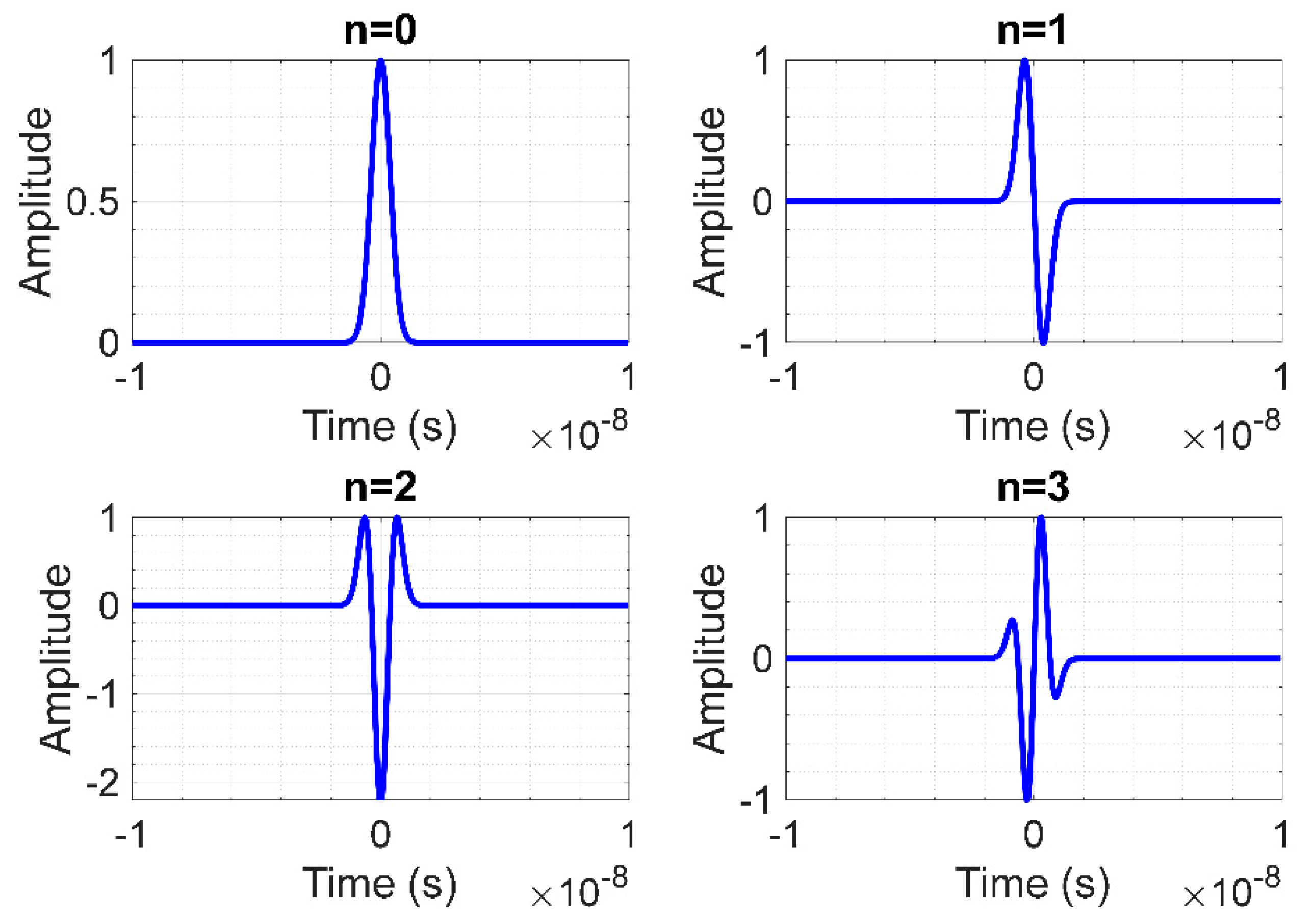
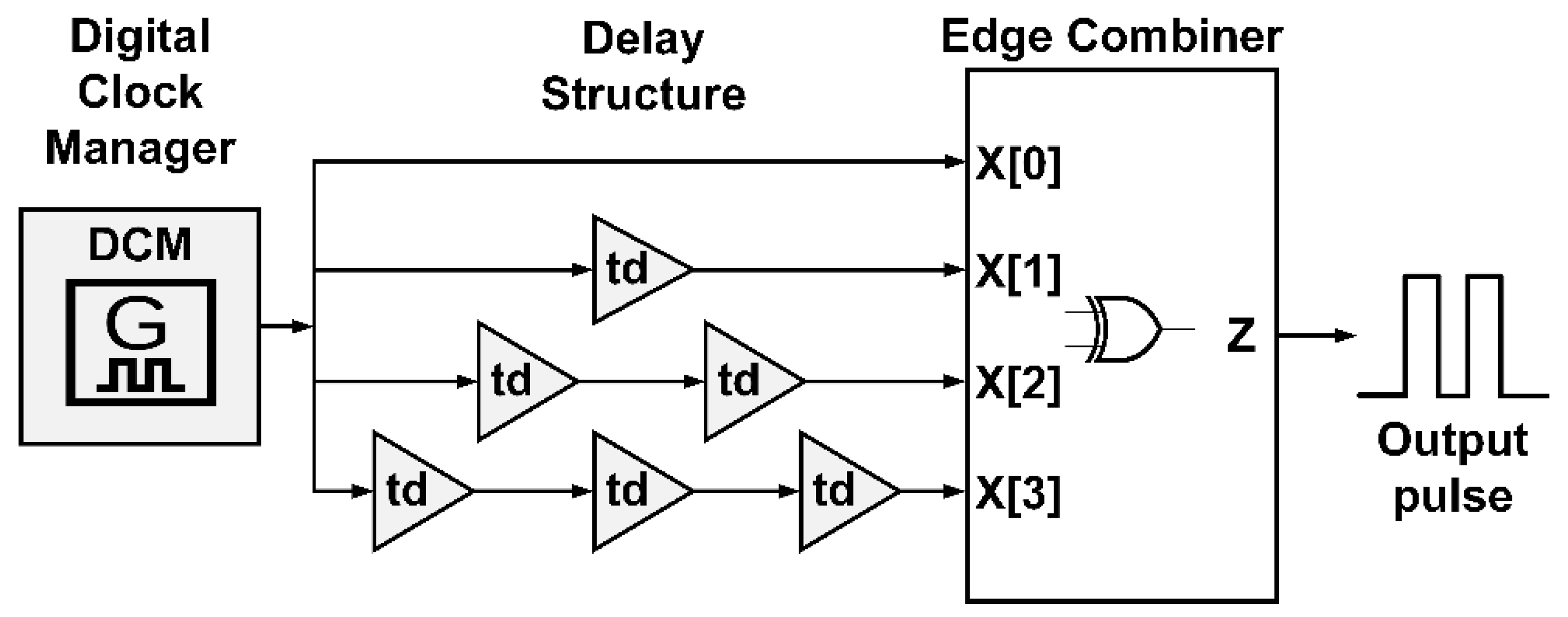


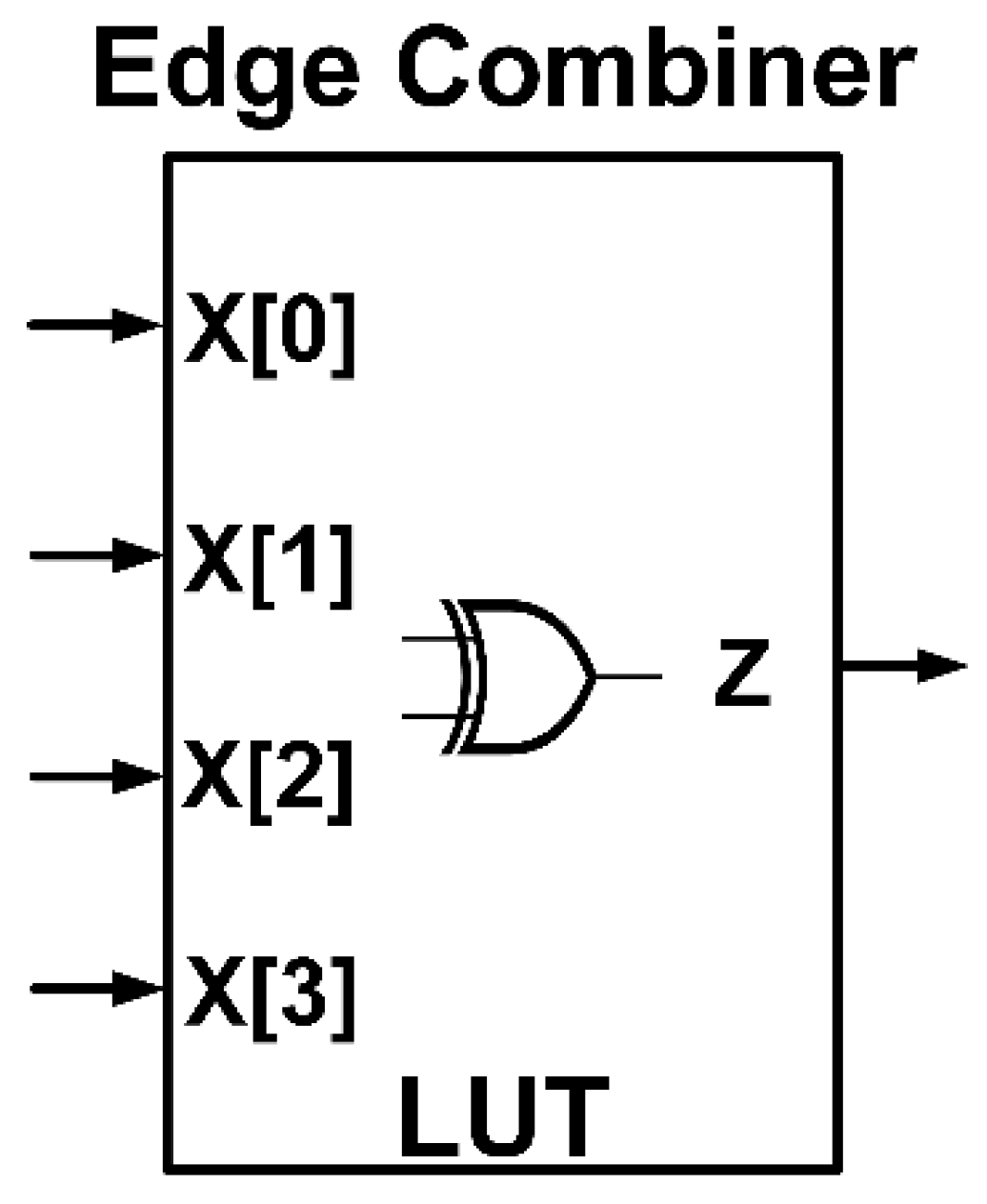


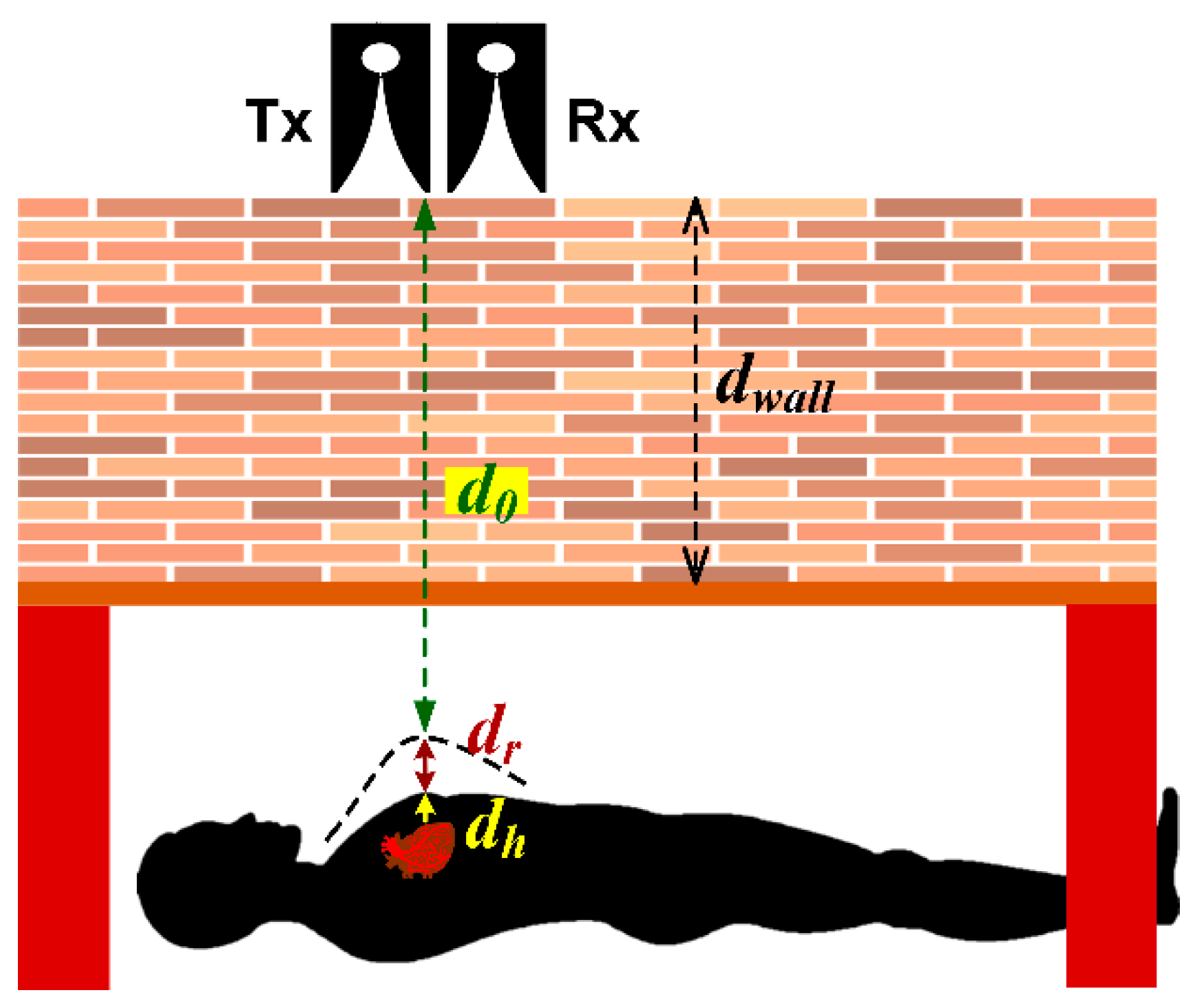




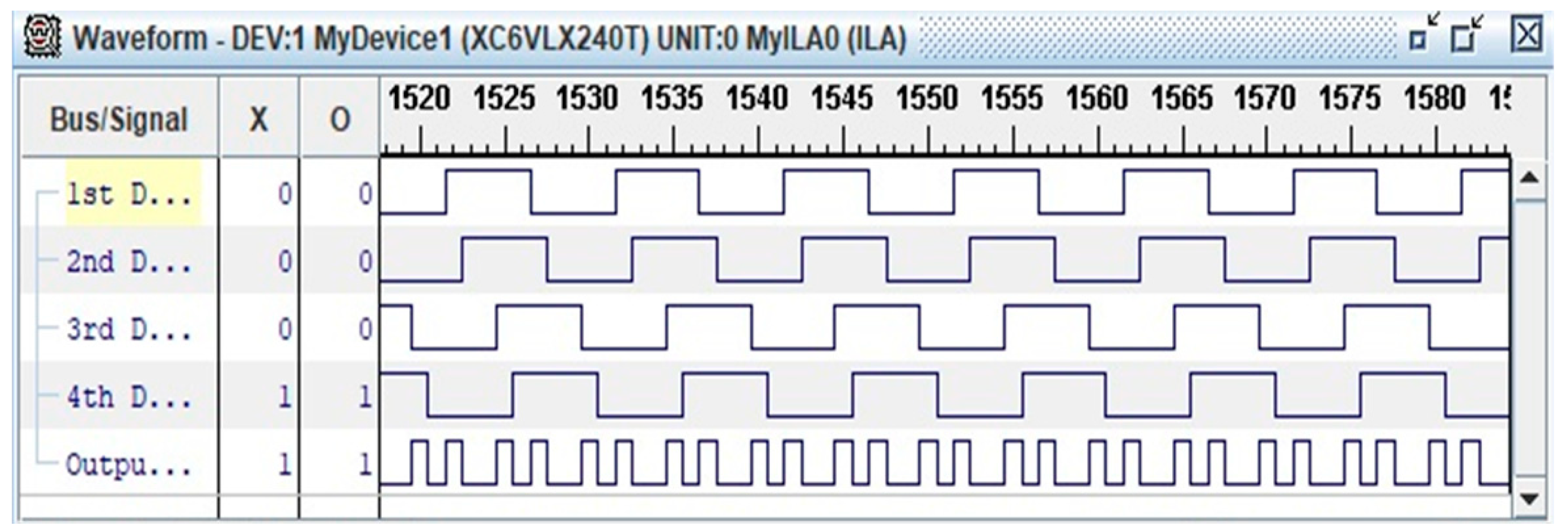




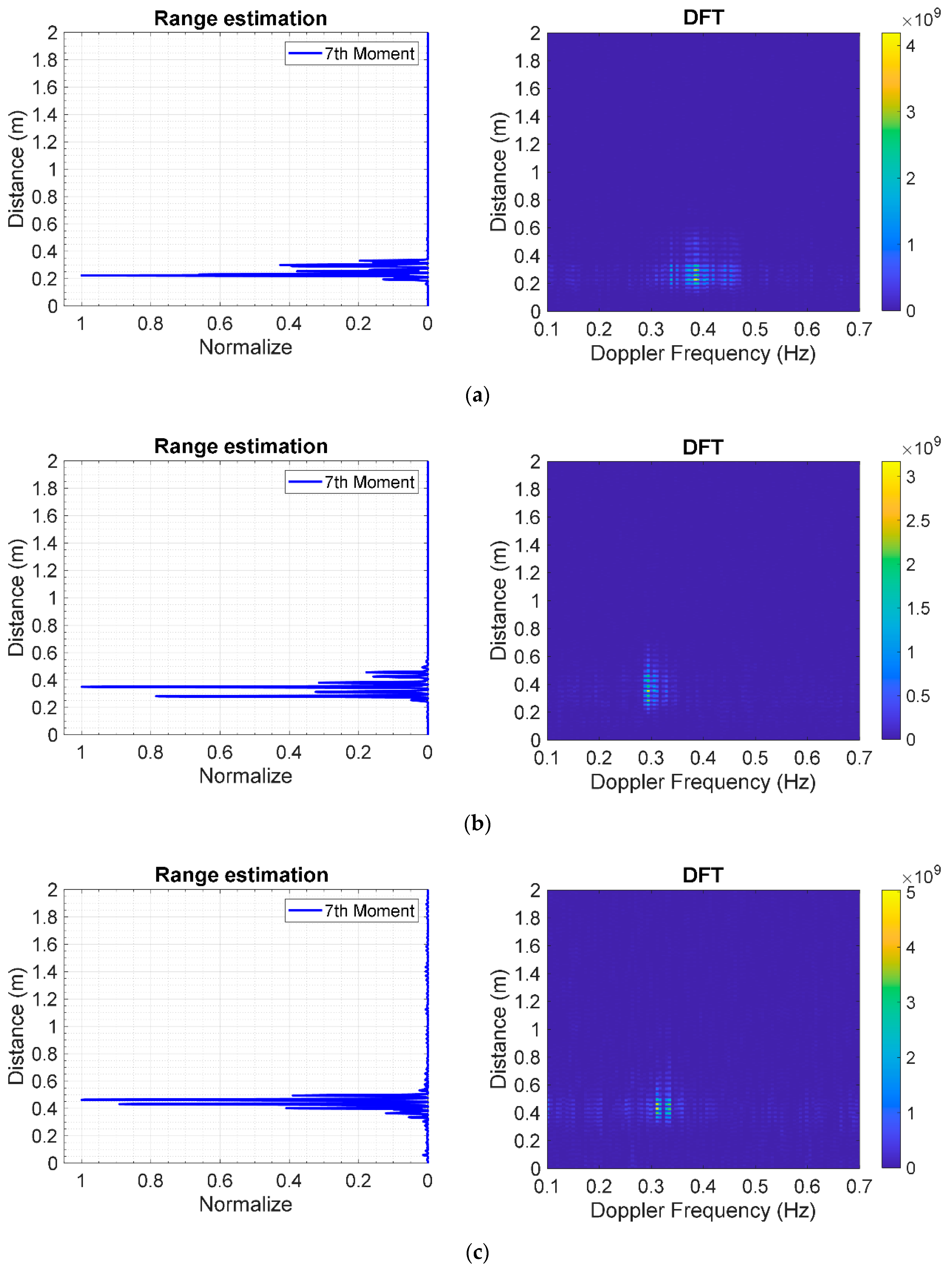

| Specifics | Ref. [44] | Ref. [45] | Current Research |
|---|---|---|---|
| IR-UWB bandwidth | 1.6 GHz | 3.83 GHz | 2.19 GHz |
| Fractional bandwidth | 1.033 | 2 | 1.797 |
| Pulse repetition frequency (PRF) | 200 MHz, 400 MHz | 20 MHz | 20 MHz |
| Signal amplitude | 611 mV | 432 mV | 456 mV |
| Human detection method | N/A | Arm swing motion (macro-doppler) | Vital sign (respiration) (micro-doppler) |
| Range estimation method | N/A | Standard Deviation | 7th moment |
| Range validation | N/A | Yes | Yes |
| Macro/Micro doppler validation | N/A | No | Yes (Respiration sensor) |
| Components | Model Name | Specification |
|---|---|---|
| Oscilloscope (ADC) | Tektronix, TDS7404B | Digital Phosphor Oscilloscope (4 GHz, 20 GS/s) |
| FPGA | Xilinx, Virtex 6-ML605 (XC6VLX240T) | Total logic cell: 241,152 cells Technology process: 40 nm Copper CMOS process |
| GPIB | Agilent Technologies, 82357B | USB/GPIB interface USB2.0, transfer rate over 850 KB/s |
| Power Amplifier (PA) | Mini Circuits, ZVE-8G | 2 GHz–8 GHz, Gain = 30 dBm |
| Low Noise Amplifier (LNA) | R&K-AA260-0S | 2 GHz–5 GHz, Gain = 26 dBm |
| Spectrum Analyzer | Anritsu, MS8609A | Digital Mobile Radio Transmitter Tester, 9 kHz–13.2 GHz |
| Tx, Rx Antennas | Vivaldi antenna | 0.7 GHz–2.5 GHz, Gain = 11 dBi |
| Respiratory measurement sensor | Great Lakes Neurotechnologies, BioRadioTM | Wireless Biomedical monitor, Chest Interface cables belt sensor. |
© 2020 by the authors. Licensee MDPI, Basel, Switzerland. This article is an open access article distributed under the terms and conditions of the Creative Commons Attribution (CC BY) license (http://creativecommons.org/licenses/by/4.0/).
Share and Cite
Tantiparimongkol, L.; Phasukkit, P. IR-UWB Pulse Generation Using FPGA Scheme for through Obstacle Human Detection. Sensors 2020, 20, 3750. https://doi.org/10.3390/s20133750
Tantiparimongkol L, Phasukkit P. IR-UWB Pulse Generation Using FPGA Scheme for through Obstacle Human Detection. Sensors. 2020; 20(13):3750. https://doi.org/10.3390/s20133750
Chicago/Turabian StyleTantiparimongkol, Lalida, and Pattarapong Phasukkit. 2020. "IR-UWB Pulse Generation Using FPGA Scheme for through Obstacle Human Detection" Sensors 20, no. 13: 3750. https://doi.org/10.3390/s20133750
APA StyleTantiparimongkol, L., & Phasukkit, P. (2020). IR-UWB Pulse Generation Using FPGA Scheme for through Obstacle Human Detection. Sensors, 20(13), 3750. https://doi.org/10.3390/s20133750






